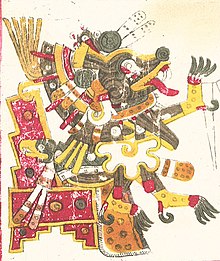Xolotl
Tampilan

Dalam mitologi Aztek, Xolotl (pelafalan Nahuatl: [ˈʃolot͡ɬ] ⓘ) adalah dewa yang diasosiasikan dengan petir dan kematian. Ia diasosiasikan dengan senja dan akan memandu Matahari saat datang ke dunia bawah tanah setiap malam. Anjing dikaitkan dengan Xolotl. Dewa tersebut dan seekor anjing diyakini memandu roh pada perjalanannya menuju dunia bawah tanah.[1] Ia umum digambarkan sebagai anjing mengerikan. Zolotl adalah dewa api dan petir.[2] Ia juga merupakan dewa anak kembar, monster, kesialan, sakit dan cacat. Xolotl adalah saudara anjing dan kembaran dari Quetzalcoatl,[3] keduanya adalah putra dari perawan Coatlicue. Ia adalah personifikasi gelap dari Venus, bintang sore, dan diasosiasikan dengan api surgawi.
Catatan
[sunting | sunting sumber]- ^ "Dog Effigy". The Walters Art Museum.
- ^ Johns 2008 p. 25
- ^ Milbrath 2013 p. 83
Referensi
[sunting | sunting sumber]- Seler, Eduard (2010). Mexican And Central American Antiquities, Calendar Systems And History. translated by Charles P. Bowditch. Kessinger Publishing, LLC. ISBN 978-1-169-14785-0.
- Milbrath, Susan (2013). Heaven and Earth in Ancient Mexico: Astronomy and Seasonal Cycles in the Codex Borgia. University of Texas Press. ISBN 978-0-292-74373-1.
- Neumann, Franke J. (1975). "The Dragon and the Dog: Two Symbols of Time in Nahuatl Religion". Numen, Vol. 22, Fasc. 1 Apr 1975. Brill Publishers: 1–23.
- Johns, Catherine (2008). Dogs: History, Myth, Art. Harvard University Press. ISBN 978-0-674-03093-0.
- Maffie, James (2013). Aztec Philosophy: Understanding a World in Motion. University Press of Colorado. ISBN 1-45718-426-5.
- Johnson, Buffie (1994). Lady of the Beasts: The Goddess and Her Sacred Animals. Inner Traditions International. ISBN 0-89281-523-X.
- Spence, Lewis (1994). The Myths and Legends of Mexico and Peru. Senate; New edition. ISBN 1-85958-007-6.
- Spence, Lewis (2015). The Magic and Mysteries of Mexico: Or the Arcane Secrets and Occult Lore of the Ancient Mexicans and Maya (Classic Reprint). Forgotten Books. ISBN 1-33045-827-3.
- Boone, Elizabeth Hill (1985). Painted Architecture and Polychrome Monumental Sculpture in Mesoamerica. Dumbarton Oaks Research Library and Collection. ISBN 0-884-02142-4.
- Boone, Elizabeth Hill (2013). Cycles of Time and Meaning in the Mexican Books of Fate. University of Texas Press. ISBN 978-0-292-75656-4.
- Sweely, Tracy L. (1999). Manifesting Power: Gender and the Interpretation of Power in Archaeology. Taylor & Francis. ISBN 0-415-17179-2.
Pranala luar
[sunting | sunting sumber]Wikimedia Commons memiliki media mengenai Xolotl.
